Our art architecture project is moving on. We’ve started to look at perspective and how to draw in a way that gives shape and depth.
First project was to use this idea and draw a simple square house with some elements of perspective to it. The point of the exercise was to get them to see what was ‘wrong’ with it – how the back moved away but the front didn’t really fit and had flat on windows. The problem is subtle but they got it. Some of them got it so well they found it extremely difficult to do the project wrong in the right way, as it were 😀
Poppy and Skye are very artistic and a lot of what we do is sort of simple for them as they can draw beautifully – mine are still stretching their upper limits and learning skills that comes naturally to the others. It’s often interesting though that the group still seems to work; everyone seems to learn something different, whether it is a good drawing technique or a following instructions technique. I’m pleased that mine are beginning to stretch upwards and exceed what we ask of them and the drawings are getting harder to tell who did what, certainly.
I think the biggest benefit in recent weeks has come from the way we’ve grouped ideas together and there has been a thread that moves them on. We mostly use the Art Projects site or a book but we’ve worked hard at trying to make it a coherent skill building exercise.
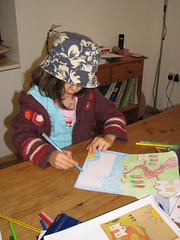
Next was a simple, but again effective, distance perspective picture which introduced the idea of a vanishing point.
They liked doing this one 🙂
After some playing, we came back to the days finale; Zoe had found a street scene with lamp posts and trees but we were not sure if they had the thought energy left for something that might look daunting, so we went for the simpler terrace street effect.
I was taught two point perspective by my mum and just about dredged this up from my head. Zoe added creative intelligence and got it working. We’ve got a few ‘deliberate mistakes’ (!) in our pictures but I never think it is a bad thing for kids to see you working away at getting something right. I quite like that the kids know you don’t have to be a specialist to access something and I love muddling through and producing results too.
We all googled a bit and looked at examples that inspired us to work at more difficult versions next time we have a full session and I think we’ve got enough skills for drawing Lego houses next time. I’m also going to nip around a few new build estates and see if I can get some artist impressions of houses for us to explore. We got out Zoe’s house elevation drawings their architect did too.
Josie deserves a special mention, given she is only six. I did help her a lot, as I think the technicalities would have been beyond her, but she stuck with this the whole way through, did all the lines and shading in the parts that needed keeping, was very thoughtful about using the right vanishing points and coloured the end result very carefully.
I love that mine, who are more or less able at free drawing (Maddy being the most natural) are getting to learn skills that are giving them artistic confidence. I never learned them really and got frustrated quickly. Fran was just thrilled with her one; it’s the most competent thing she has achieved I think and she liked it enough to do another the next day. She was VERY impressed to be able to spot vanishing points in two street paintings on a wall the next day.
Another successful day. I think they’ll be ready to move on to a final phase or using these skills more competently now and then we’ve got a field trip planned and a way of moving from this project on to a new theme which should 😆 be almost seamless!
This was the inaugural outing of the ‘art box’ – I’m rather proud of this resource, so I’m going to do a post about it soon 😀


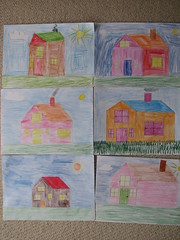
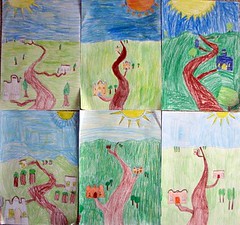

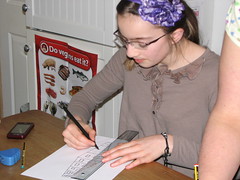
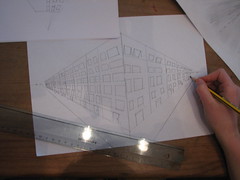
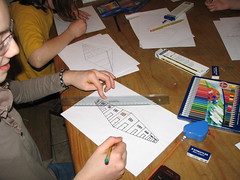
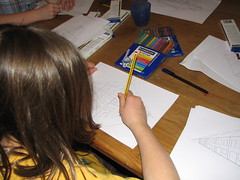
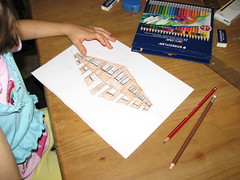
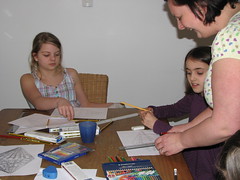
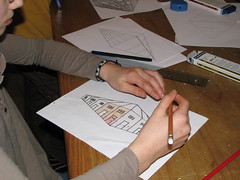
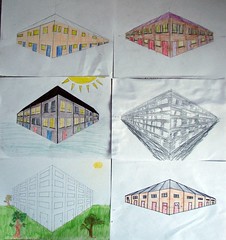


Excellent, I am very impressed!!
I’m glad you like. Of course, I keep forgetting that I actually can’t do these things. I think of myself as having learned it too – I’m going to have to start sitting down and doing homework to keep up I think!
You might try drawing axonometric elevations next. I’m sure there will be instructions on-line somewhere, but I remember finding this method really mind blowing when I did it in the first year of my masters degree! Essentially you start with a floor plan of a building, and then draw vertical lines from each corner. For a conventional ‘box’ building these lines should all be the same length (height). If you join these together with (horizontal/slanting) lines in the relevant places then you should get start to get a three dimensional shape emerging.. Not sure if those instructions make any sense, but anyway – you do some great stuff with your girls, bravo.